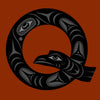Rare Antique Kayak with Figures, late 19th Century, Aleut
Regular price
$3,500.00
Sale
Late 19th Century
Aleut Culture, Alaska
4" high x 28" long x 4.5" wide
Kayak: wood frame with seal skin covering, red wool decorative tuffs
Figures: wood, wearing seal gut parkas, carved and painted faces and hats, holding 6" carved and painted paddles
Note: seal skin covering cut away in sections to expose wooden frame
Tourism was a well-known feature of life along the Alaskan coast in the late 19th century. Steamships frequented the harbors on the southeastern coast, and during the summer months, wealthy tourists traipsed through Juneau in search of souvenirs. In the 1890s, a wooden walkway had been built across the moraine at Muir Glacier in Glacier Bay, making the hike easier for the several hundred visitors that came each year. At Sitka and Wrangell, the arrival of a steamship turned the town into a temporary but festive market place. Natives quickly produced goods to entice tourists to buy: small carvings, jewelry and baskets were the most popular items.
The Aleut peoples of the Aluetian Islands created model versions of objects used in their daily life. A popular tourist item was the model kayak. Before the arrival of the Russians, the one-hole baidarkas (kayaks) were found in abundance, along with some two-hole boats. The Russians later came to hunt fur-bearing animals, and the Russian influence on the design of the kayaks was significant, resulting in three-hole kayaks. These were probably configured with the stern man paddling and guiding the craft, while the bow man was responsible for using the atlatl (throwing board) in the hunt, with the hunt boss in the middle directing the hunt.
This particular model kayak depicts the three-hole kayak described above.











